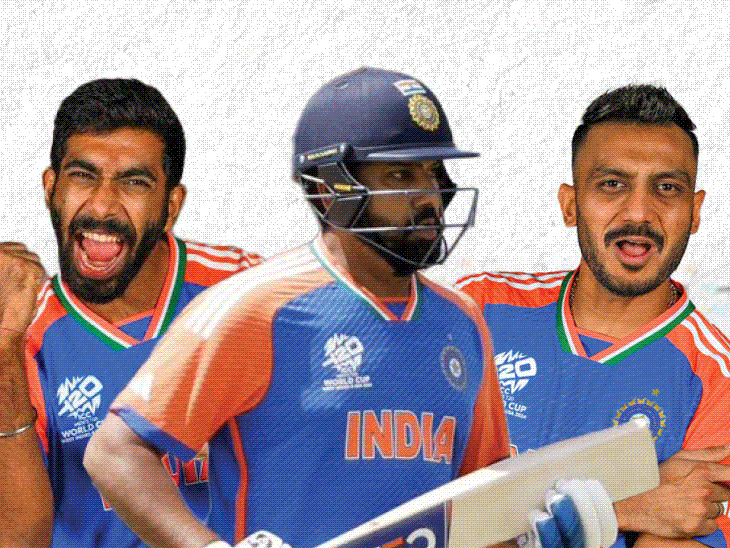If we look at an entire period of history, the vast and vast piece of land that has to be passed through while measuring the distance from the height of the Himalayas to the depth of the ocean, it has been something else altogether. When you look back at time by turning page by page, you will see how beautifully a different structure of culture and civilization has been developing. The sagas and stories through which this entire process of evolution from Adam has reached us are documented in the Vedas, Puranas, Upanishads and scriptures. In today's times, because they have become even more ancient than ancient, even if we dismiss these documents as mere imagination, the wisdom and understanding that is filled within them cannot be denied. The sutras like Tamaso Ma Jyotirgamaya, Satyam Vad, Dharmam Char as well as Satyamev Jayate are the achievements of human life.
When Pandit Jawaharlal Nehru also mentions the Vedas and the Vedic era in Discovery of India, he writes that the Vedas are the first thoughts that emerged in the human mind. It is pure, natural and the man of that time (whoever he may have been, a sage or a wise man) told others what he saw and felt about his nature. Veda did not say that 'what I am saying is the ultimate truth' but left scope for improvement and change in everything said. This feeling of contemplation in the Vedas gradually developed to such an extent that it appealed to religion itself and said – O religion, give us faith.
Then the Vedas did not worship God but themselves raised questions as to whom they should worship and why. How to do it, why to do it and what is the right and simple way of worship? What is life? What is the way to live life? What is Prana? Who is it? Who am I? Where am I, why am I…this series of questions lasted longer than the series of answers. Rather, it would be more correct to say that the process of reply has been going on till now. When it became more difficult to understand these questions and their answers, the concept of Purana Purusha came to the fore.
The Puranas tell us that He is a power by which everything is moving and moving. The 129th Sukta in the Dasham Mandal of the Rigveda is Nasadiya Sukta, which puts forward these questions in the best and clearest way.
Nasadasinno sadasattadanin nasidrajo novyoma paroyat.
Kimavarivah Kuhakasya Sharmannambh Kimasid Gahanangbhiram ॥1॥
The first verse of this hymn says that, before the creation of the universe, there was no Sat (essence or truth). There was neither space nor sky. There was no heaven or death world either. Then who was there, who had hidden it, where was it in the depths, because there were no oceans either.
Neither Mrityu Rasidam nor Tarhi nor Night, Ahn Asitpraketah.
अनीद वातं स्वधाया तदेकं तस्मादधान्यन् पर किं च नास ॥2॥
The second verse says that, when there was no death at that time, there were no day and night. There was no holocaust. Who was that vital air, where was Maya and where was Brahma, the biggest of all. Was there something beyond these? If there was, where was it?
A long series of Nasadiya Sukta is a collection of these questions. These questions show that the person and society that wrote the Vedas or the mantras of the Vedas was not a society that would follow blind sheep or get scared under the influence of some supreme power. Rather, first he used to think, ask questions, try to understand and also discuss them with other people. The Vedas have accepted the discussion on a large scale and this entire document is our most important heritage as the biggest discussion in the Indian history. One of the main conclusions of which is – Ekam Sat Vipra Bahuda Vadanti. That means there is only one truth and knowledgeable people call it by different names.
This means that the search for truth is the first thought that flashes in the human mind. This search is still going on. Quoting the Upanishads and Puranas, it is revealed that in this crowd of people who lead a normal life of eating, earning and living and dying, there are some people who have traveled far and wide carrying the banner of search for truth. So far away that the doors of life-death and heaven-hell meet each other. One such story is of seven year old boy Nachiketa.
Nachiketa, who may have been only five or seven years old, but the thoughts flashing in his human mind had progressed a lot. In Kathopanishad, Nachiketa has been described as the first curious person of the world.
It is a matter of Vedic era. If we consider the period also, then this must have been the time of Satyayuga. At this time, Vajashrava became a great sage. Vajashrava had a son named Vajashravas. Vajashravas was brilliant and he soon memorized the verses of the Vedas and the mantras of the Yagya offerings. With time Vajshravas grew young, got married and then became the father of a healthy son. One day Vajashravas performed the ritual of Vishvajit Yagya and took a pledge that he would donate all his property and cows.
At this time his son, whose name was Nachiketa, was a five-year old boy. If any event is organized at home, there is joy and happiness in the hearts of the children. Nachiketa was also very happy with the Yagya and this ritual, but when his father started donating his cows, he became sad. In fact, all the cows of Rishi Vajshravas had grown old and many of them were sick and did not even give milk. Nachiketa started thinking that what his father was doing was not charity but cunningness. You should donate your favorite things. He had heard this from an Acharya in the ashram.
He went to his father to say the same thing. Taking a pledge to donate, he held his father's hand and said, “What are you doing?” Why are you donating your old cows, they are of no use. The father pushed him aside and then started taking the pledge of charity. Nachiketa started explaining to them again. He said – Father, we donate to the one who is most dear to us, right? Then I am the most dear to you. Yes, I am the most dear to you. Then who will you donate to me?
Nachiketa, feeling very confused, started asking this question to his father. He started asking again and again, whom will you donate to me? Who will you donate to me? Who will you donate to me? Nachiketa's father, irritated by these repeated questions, became angry and scolded Nachiketa and said – Go, I am donating you to Yama.
Lord Shri Ram is famous for following his father's orders that he went to the forest to follow his promise, but Nachiketa, even in anger, took his father's words seriously and happily accepted it and went to Yama. Started preparing for. Yama, who is the god of death and approaching whom means nothing but death, yet Nachiketa walked on that path. The mother started crying, the father became sad and repentant, but Nachiketa remained firm. He said, now that I have been given in charity, I will go to the place to which I have been given in charity.
Despite being stopped, Nachiketa did not stop, he started walking. A child from the same human society which is desperate only for life, set out in search of death. Here the question may definitely arise that how did Nachiketa go to death? Did he go with his body or after his death? Because it is not easy to go near death and even if one goes, only the soul can go there, not the body. Well, Nachiketa set out crossing rivers, mountains and forests. It is said that after traveling for several days he reached the door of death.
Here Yama's gatekeeper stopped him and asked him to return, but Nachiketa did not come to return. He stood there and insisted on meeting Yama. His wait continued for three days. At last, seeing his condition, Yama melted and came out. The three days that Nachiketa waited symbolize the three stages of life: childhood, youth and old age. After three days, the arrival of Yama means the arrival of death.
When Yama came, he also asked Nachiketa to return, then Nachiketa demonstrated his cleverness and intelligence. He said, is it possible for someone who dies to return? Isn't this against your constitution and the cycle of time? After listening to that little boy, Yama got really confused in his words. Then Yama, who is known for his cruelty and severity, became kind and gentle and lovingly made Nachiketa sit in his lap and asked, Well tell me, why have you come? Nachiketa told what was donated by his father. Yama said, okay I became your guardian, gave you fearlessness, what else do you wish?
Nachiketa said, now there is no desire, just follow your religion. Yamraj again got confused, what is my religion? Nachiketa said- Being a guardian, you give me knowledge and also guidance, this is what guardians do. Yamraj laughed. A seven year old boy had made him his guru. Then Yamraj gave all that knowledge to Nachiketa which is the essence of the Vedas, the definition of the Puranas and which is our curiosity even today as a human being.
This story of Nachiketa has been told in different ways in other texts including Upanishads. However, this is the gist of it all. Even in Shanti Parva of Mahabharata, the story of Nachiketa comes during the explanation of birth-death and Karmayoga. It is said that, when Nachiketa stayed at Yama's door for three days without eating or drinking, Yama felt sad that the Brahmin guest stayed at his door for three days without food and water. An example of the tradition of Atithi Devo Bhava can also be seen here.
To compensate for his mistake, Yama said to Nachiketa, “You have spent three days at my door without food and water, so ask for three boons from me. Nachiketa first asked for peace for his father and himself. In the second boon, Nachiketa Learned the sacred fire knowledge. In this way Yama gave another name to Agni, Nachiketa Agni. In the third boon, Nachiketa wanted to know the death of the body and its secret.
Yama did not want to give this final knowledge to Nachiketa. He said that this is a mystery even for the gods. He asked Nachiketa to ask for some more boons and asked him to take many luxuries, comforts, kingdom and society, but Nachiketa did not get trapped in any such greed. He remained adamant in attaining the knowledge of the soul. Pleased with Nachiketa, Yama made him his disciple and gave Nachiketa the knowledge of the secret of self. Told him about the element and whatever else he said was something like this,
Om is Brahma.
The soul, whose symbol is Om, is the omnipresent Brahman. The smallest and the biggest are the same.
The goal of the wise is to know this soul.
The soul is like a rider; The horses are the senses, which he guides on the path through the labyrinth of desires.
Only the soul remains after death; The soul is immortal.
The soul cannot be realized merely by reading the scriptures or by intellectual education.
The soul should be considered separate from the body, which is the seat of desire.
Due to not understanding Brahma, man gets trapped in the cycle of rebirth. By understanding one attains salvation.
After gaining knowledge from Yama, Nachiketa returned to his father. Vajshravas had also realized his mistake. He took up sannyasa. Nachiketa became engaged in spiritual practice.
The story of Nachiketa included in Kathopanishad is not the first story of curiosity, nor is it the last installment. Rather, this story is most important in understanding life and is a means of awakening human consciousness. This story is just a glimpse of what is hidden in the Vedic tradition.





